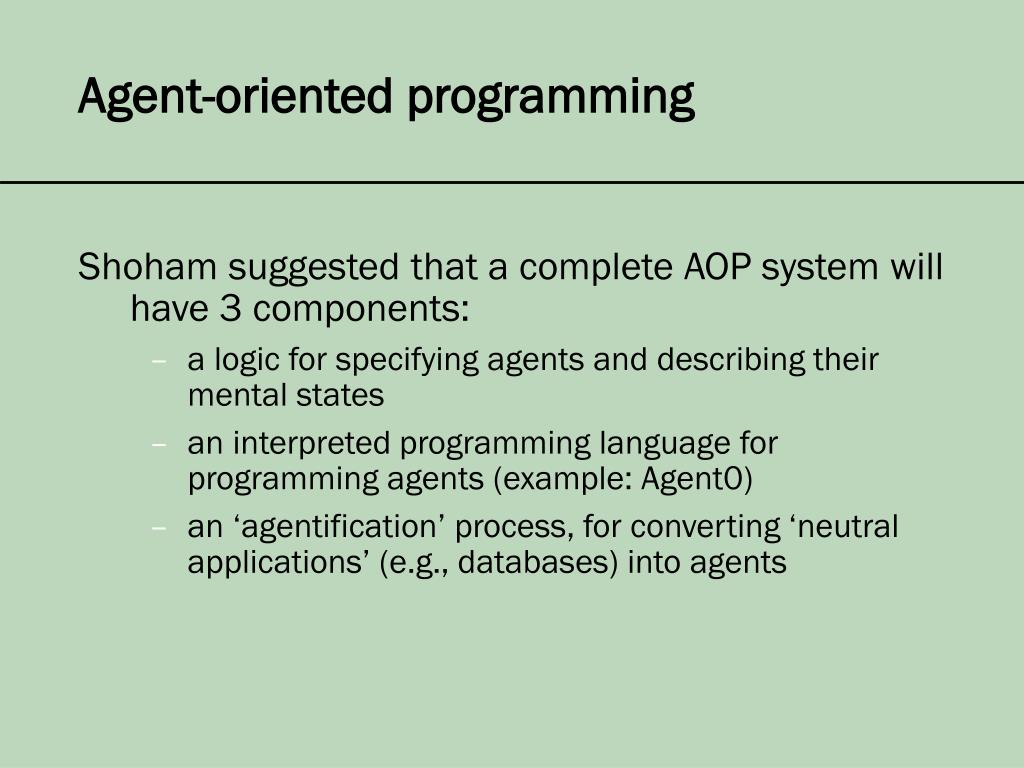Agent-Oriented Programming in Mobile Agents: Advancing Flexibility and Autonomy in Distributed Systems
Imagine software programs that think, learn, and make decisions independently, like digital assistants with their own minds. This is the realm of agent-oriented programming (AOP) in mobile agents, transforming how we create intelligent software.
Traditional software development dictates every step to computers. However, agent-oriented programming takes a radically different approach, creating autonomous digital entities that analyze situations and act independently, similar to human decision-making.
These mobile agents are smart, roaming programs that move between devices and systems, gather information, make decisions, and perform tasks without constant human oversight. Whether managing your smartphone’s resources, optimizing network traffic, or coordinating with other digital agents, these intelligent programs are reshaping mobile computing.
We’ll explore how these digital agents think and work, their practical applications in mobile computing, and the unique challenges they present. We’ll also see how modern platforms like SmythOS simplify creating and deploying these autonomous agents.
Agent-oriented programming enables intelligent, autonomous systems that can independently make decisions, interact with other agents, and adapt to changes in real-time, transforming AI’s capabilities.
Discover how this groundbreaking approach is revolutionizing mobile computing, paving the way for more intelligent, adaptable software systems that work alongside us in increasingly sophisticated ways.
Fundamentals of Agent-oriented Programming
Agent-oriented programming (AOP) marks a significant shift in developing autonomous software systems. AOP focuses on creating intelligent agents that can think and act independently, similar to how humans process information and make decisions. These agents actively perceive their environment, reason about their observations, and take actions to achieve their goals.
The cornerstone of AOP is its use of cognitive architectures, particularly the Belief-Desire-Intention (BDI) model. The BDI model, as implemented in software systems, equips agents with beliefs about their environment, desires they aim to achieve, and intentions representing their committed plans of action. This mental model allows agents to balance time between planning and executing those plans.
What sets AOP apart from traditional programming paradigms is its emphasis on autonomy and independent decision-making. Unlike conventional software that follows rigid, predefined instructions, agent-oriented programs adapt their behavior based on their perception of the environment and internal reasoning process. This flexibility enables them to handle complex, dynamic situations where the right course of action isn’t always clear in advance.
Think of an agent as a digital entity with its own ‘mind’—it maintains an understanding of its world through beliefs, pursues objectives through desires, and commits to specific actions through intentions. This cognitive approach allows agents to exhibit behaviors like planning, learning, and collaborating with other agents to solve complex problems.
The practical implications of AOP extend beyond theoretical computer science. These autonomous agents can be deployed in scenarios requiring sophisticated decision-making capabilities, from managing smart home systems to coordinating autonomous vehicles. By providing agents with the ability to reason about their environment and make independent decisions, AOP opens up new possibilities for creating more intelligent and adaptable software systems.
Applications of AOP in Mobile Computing
Aspect-Oriented Programming (AOP) has transformed the development of smart applications that operate independently on mobile devices. This technology goes beyond traditional software development, enabling a new generation of autonomous applications that handle complex tasks without constant human oversight.
In healthcare settings, AOP-powered mobile applications serve as vigilant digital guardians. Medical professionals now rely on these intelligent systems to monitor patient conditions around the clock, tracking vital signs and alerting healthcare teams when intervention is needed. These applications work tirelessly in the background, processing streams of health data to identify concerning patterns that might escape human observation.
Smart home environments showcase another compelling application of AOP in mobile computing. These systems autonomously manage energy consumption by learning household patterns and adjusting settings accordingly. Imagine your home automatically dimming lights in empty rooms, adjusting the thermostat based on occupancy patterns, and optimizing power usage during peak rate periods—all without requiring manual input.
The beauty of AOP in these applications lies in its ability to separate core functionality from cross-cutting concerns like security, logging, and error handling. This separation allows developers to create more maintainable and efficient applications while ensuring critical features like data privacy remain robust across all system components.
As mobile devices become increasingly powerful, AOP’s role in enabling autonomous applications continues to expand. From predictive maintenance in industrial settings to personalized wellness coaching, these smart applications are transforming how we interact with technology in our daily lives. Their key advantage is the ability to operate independently while maintaining high levels of reliability and security—essential qualities in today’s interconnected world.
Challenges in Developing Mobile Agents
Mobile agent development presents several formidable technical hurdles that researchers and developers must navigate carefully. A critical challenge is system integration, where agents need to seamlessly interface with a diverse ecosystem of existing platforms and infrastructure. According to research from the Communications of ACM, this integration complexity often requires sophisticated execution environments that can support agent mobility while maintaining system stability.
Security is another paramount concern in mobile agent development. These autonomous programs must be protected from malicious hosts and other agents, while the systems they interact with need safeguards against potentially harmful agent behaviors. The challenge intensifies when agents carry sensitive information across networks, as they become vulnerable to various forms of attacks and data breaches.
Performance optimization represents a persistent challenge, particularly when agents need to operate across different network conditions and device capabilities. Mobile agents must efficiently manage their resource consumption, including memory usage and processing power, while maintaining responsive operation even under constrained environments. This balancing act becomes especially critical when multiple agents need to coordinate their activities.
Network compatibility poses its own set of complexities. Agents must be designed to handle diverse network protocols, manage intermittent connectivity, and adapt to varying bandwidth conditions. The ability to maintain operational continuity despite network fluctuations requires robust failover mechanisms and intelligent state management capabilities.
Device compatibility presents another layer of complexity. With the proliferation of different hardware platforms and operating systems, agents need to be engineered with sufficient abstraction to function consistently across heterogeneous devices. This includes adapting to different processing capabilities, memory constraints, and platform-specific features without compromising core functionality.
Autonomous Operation Challenges
The autonomous nature of mobile agents introduces additional challenges around decision-making and operational independence. Agents must possess sophisticated logic to make intelligent choices without constant human oversight while ensuring their actions align with intended objectives.
Real-time adaptation capabilities are crucial for autonomous operation. Agents need to dynamically adjust their behavior based on environmental changes, system states, and interaction outcomes with other agents. This adaptability must be balanced with maintaining predictable and controllable agent behavior.
Resource management becomes particularly challenging in autonomous scenarios. Agents must efficiently allocate and release resources, prevent deadlocks, and optimize their operation while respecting system constraints. This includes managing computational resources, network bandwidth, and energy consumption, which is especially critical for agents operating on mobile devices.
Coordination among multiple autonomous agents adds another dimension of complexity. Agents must effectively communicate, negotiate, and collaborate while avoiding conflicts and maintaining operational efficiency. This requires sophisticated protocols for agent discovery, communication, and conflict resolution.
Error handling and recovery mechanisms are essential for maintaining reliable autonomous operation. Agents must be capable of detecting and responding to various failure scenarios, including network disruptions, resource constraints, and unexpected system states, while maintaining data integrity and operational continuity.
Leveraging SmythOS for Mobile Agent Development


Modern mobile agent development demands sophisticated tools that can handle complex workflows while maintaining security and performance. SmythOS emerges as a standout solution, transforming how developers approach autonomous agent creation with its comprehensive feature set. The platform’s visual builder represents a significant leap in agent development efficiency. Rather than wrestling with intricate code, developers can craft sophisticated agent behaviors through an intuitive drag-and-drop interface. This visual approach doesn’t just save time—it opens up agent development to a broader range of professionals, democratizing the creation of intelligent mobile solutions.
Built-in monitoring capabilities set SmythOS apart from traditional development platforms. The system provides real-time insights into agent behavior, performance metrics, and system-wide interactions, enabling developers to quickly identify and resolve bottlenecks. This level of visibility ensures optimal performance as agent systems scale. By integrating AI agents as API endpoints or custom plugins, SmythOS enables enhancements across various platforms while maintaining robust security protocols.
According to AI Tools Explorer, SmythOS provides access to over 300,000 integrations, allowing developers to connect their agents with various apps, APIs, and data sources. This extensive integration capability ensures that mobile agents can interact seamlessly with existing infrastructure while maintaining enterprise-grade security standards. The platform’s emphasis on security is evident in its comprehensive protection measures.
SmythOS incorporates robust security controls and monitoring capabilities, ensuring that autonomous agents operate within defined parameters while protecting sensitive data. This security-first approach makes it particularly valuable for enterprise deployments where data protection is paramount.
Performance optimization in SmythOS goes beyond basic monitoring. The platform automatically handles resource allocation and scaling, ensuring that mobile agents maintain their efficiency even under increasing workloads. This automated resource management frees developers to focus on enhancing agent functionality rather than wrestling with infrastructure concerns. For organizations seeking a reliable foundation for mobile agent development, SmythOS delivers a compelling combination of accessibility, security, and performance. Its integrated approach streamlines the development process while ensuring that the resulting agents are both robust and adaptable to changing requirements.
Best Practices for AOP Implementation
Agent-oriented programming (AOP) represents a significant advancement in software development, enabling the creation of autonomous digital entities that can think and act independently. Success in AOP implementation hinges on three foundational pillars: modular design, continuous monitoring, and interdisciplinary collaboration.
A modular design approach serves as the cornerstone of effective AOP implementation. According to industry research, breaking down complex systems into manageable, independent modules allows developers to isolate functionality, minimize dependencies, and enhance system maintainability. Each agent module should encapsulate specific behaviors and capabilities while maintaining clear interfaces for interaction with other agents.
The implementation of continuous monitoring mechanisms proves crucial for maintaining system health and performance. Developers must establish comprehensive monitoring protocols that track agent behaviors, resource utilization, and interaction patterns. This ongoing surveillance enables quick identification of potential issues and ensures optimal system operation. Real-time performance metrics help teams understand how agents behave in production environments and inform necessary adjustments.
Interdisciplinary collaboration emerges as a vital component in successful AOP implementations. The complexity of agent-based systems often requires expertise from various domains—from artificial intelligence specialists to domain experts who understand the specific business context. Early involvement of stakeholders from different disciplines helps ensure that agent behaviors align with both technical requirements and business objectives.
Beyond these core pillars, successful implementation requires careful attention to interface design between agents. Well-defined communication protocols and standardized message formats facilitate smooth interaction between autonomous agents. This standardization becomes particularly critical as systems scale and new agents are introduced into the environment.
| Tool | Type | Key Features | Pricing |
|---|---|---|---|
| Azure Monitor | SaaS | Full-stack observability, integration with Azure DevOps, automated alerts | Varies by usage |
| AppDynamics | SaaS/On-premises | Full-stack observability, root cause analysis, user experience monitoring | Starts at $6/month per CPU core |
| Dynatrace | SaaS/On-premises | AI-driven insights, cloud-native support, automated monitoring | Starts at $21/month per host |
| New Relic | SaaS | Real-time health metrics, distributed tracing, customizable dashboards | Free tier available, additional tiers based on data usage |
| Datadog | SaaS | Distributed tracing, code profiling, customizable alerts | Free 14-day trial, then $15 per host/month |
Testing and validation deserve special consideration in AOP implementations. Unlike traditional software testing, agent-based systems require evaluation of both individual agent behaviors and emergent properties that arise from agent interactions. Developers should implement comprehensive testing strategies that validate both isolated agent functionality and system-wide behaviors under various conditions.
Documentation plays a crucial role in maintaining and evolving agent-oriented systems. Teams should maintain detailed documentation of agent capabilities, interaction patterns, and system architecture. This documentation becomes invaluable as systems grow and new team members join the development effort. Clear documentation also facilitates troubleshooting and system modifications as requirements evolve.
By adhering to these best practices, development teams can create robust, scalable agent-oriented systems that deliver real business value. The key lies in maintaining a balanced approach that combines technical excellence with practical considerations for long-term system maintenance and evolution.
Future Directions in Agent-oriented Programming
Agent-oriented programming is undergoing a transformative era, driven by advancements in cognitive architectures and artificial intelligence. These developments are reshaping how autonomous agents perceive, reason, and interact with their environments. Central to this evolution is the integration of sophisticated cognitive frameworks that mirror human-like decision-making processes.
One promising development is the emergence of hybrid cognitive architectures that combine symbolic reasoning with machine learning capabilities. As shown by recent research from leading researchers in autonomous systems, these architectures enable agents to learn from experience while maintaining the interpretability and verifiability crucial for critical applications.
Machine learning integration is changing how agents adapt to complex environments. Modern agents can develop sophisticated behavioral patterns through reinforcement learning and neural networks rather than relying solely on pre-programmed responses. This is particularly effective in scenarios requiring nuanced decision-making, where traditional rule-based approaches fall short. These learning capabilities allow agents to handle complex tasks while maintaining robust performance in dynamic environments.
Security measures are evolving alongside these cognitive advances. The integration of ethical reasoning frameworks and sophisticated verification mechanisms ensures that as agents become more autonomous, they remain aligned with human values and safety requirements. This development is crucial for deploying agents in sensitive domains like healthcare, financial systems, and critical infrastructure.
The future also holds exciting possibilities for large-scale agent collaboration. Advanced coordination protocols and distributed decision-making frameworks are enabling unprecedented levels of cooperation among autonomous agents. This capability is particularly valuable in scenarios requiring coordinated responses, such as disaster management or smart city operations.
Looking ahead, we can expect increasingly sophisticated agents capable of handling complex real-world scenarios with human-like adaptability. The ongoing convergence of cognitive architectures, machine learning, and robust security frameworks is creating a new generation of autonomous systems that can reliably operate in challenging environments while maintaining strict safety and ethical standards.
Conclusion: Enhancing Mobile Agents with AOP


Overview of Shoham’s AOP system components – Via slideserve.com
Agent-oriented programming represents a significant leap in developing autonomous mobile agents, fundamentally changing our approach to distributed systems development. Integrating AOP principles enables developers to create software entities that make independent decisions, adapt to changing environments, and interact seamlessly with other agents across networks.
Through AOP’s sophisticated framework, mobile agents gain remarkable capabilities that address traditional distributed computing challenges. These agents can reduce network load by processing data locally, overcome latency issues through autonomous operation, and adapt dynamically to unfavorable situations. The implementation of mobile agents particularly shines in scenarios requiring real-time responses and complex protocol handling.
The power of AOP extends beyond basic automation. By enabling agents to execute asynchronously and autonomously, developers can create solutions that maintain optimal performance even in challenging network conditions. This paradigm shift benefits applications requiring continuous operation and adaptive decision-making capabilities.
Leveraging platforms like SmythOS, developers can harness these advantages while maintaining enterprise-grade security and scalability. Combining AOP’s inherent flexibility with robust development platforms creates a powerful foundation for building next-generation mobile agent systems that handle increasingly complex distributed computing challenges.
Looking to the future, adopting AOP in mobile agent development represents a fundamental transformation in approaching autonomous systems. This approach opens new possibilities for creating more intelligent, adaptable, and efficient applications that meet the ever-growing demands of modern distributed computing environments.
Last updated:
Disclaimer: The information presented in this article is for general informational purposes only and is provided as is. While we strive to keep the content up-to-date and accurate, we make no representations or warranties of any kind, express or implied, about the completeness, accuracy, reliability, suitability, or availability of the information contained in this article.
Any reliance you place on such information is strictly at your own risk. We reserve the right to make additions, deletions, or modifications to the contents of this article at any time without prior notice.
In no event will we be liable for any loss or damage including without limitation, indirect or consequential loss or damage, or any loss or damage whatsoever arising from loss of data, profits, or any other loss not specified herein arising out of, or in connection with, the use of this article.
Despite our best efforts, this article may contain oversights, errors, or omissions. If you notice any inaccuracies or have concerns about the content, please report them through our content feedback form. Your input helps us maintain the quality and reliability of our information.
